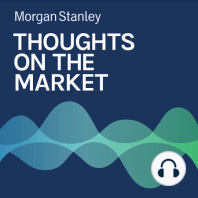3 min listen
Andrew Sheets: A Swing Towards Bonds?
ratings:
Length:
3 minutes
Released:
Nov 4, 2022
Format:
Podcast episode
Description
As prices for bonds go down and yields go up, investors may be asking why the price is so low, and what this shift may do to the broader market and asset allocation.----- Transcript -----Welcome to Thoughts on the Market. I'm Andrew Sheets, Chief Cross-Asset Strategist for Morgan Stanley. Along with my colleagues, bringing you a variety of perspectives, I'll be talking about trends across the global investment landscape and how we put those ideas together. It's Friday, November 4th, at 2 p.m. in London. The market is a funny thing. Relative to January 1st of this year, the U.S. 30 year Treasury bond is set to pay out all of the same coupons, and return the exact same amount of principal when it matures in 2052. But the market has decided that that same bond today is worth 36% less than at the start of the year. So what happened? Well, yields rose. That 30 year U.S. bond might be the exact same entity, but investors now need all of those future payments to yield 4.2% per year, not the 1.9% they needed on January 1st. It's another way of saying that there's been a major change in what's considered the minimal accepted return on safe assets. And that large jump in yields has led to the largest drop in bond prices that we've seen in recorded history. But the implications are broader. Many assets have bond-like characteristics, where you pay money today for a string of payments in the future. Whether it's an office building, a rental unit or a company with a future set of earnings, you can get very different current values for the exact same asset today by varying what sort of yield it's required to produce. And so if bonds are now priced lower to generate higher returns in the future, so should many other assets that have similar bond-like characteristics. For markets, we see a couple of implications. First, these rising yields have made bonds increasingly competitive relative to stocks. Currently, $100 of the S&P 500 is expected to yield about $6.25 of earnings next year. $100 of U.S. 1 to 5 year corporate bonds yields about $6 of interest, despite having just one sixth the volatility of the stock market. It's been 14 years since the earnings yield on stocks and the yield on corporate bonds has been so similar. Higher yields on safe assets may also shift broader asset allocation decisions. At this time last year, 30 year BBB- rated investment grade bonds yielded just 3.3%. Given such low returns, it's no wonder that many asset allocators, especially those with longer time horizons, pushed into alternative asset classes and private markets in an effort to generate higher returns. But that calculus now looks different. Yields on those same investment grade bonds have risen from that 3.3% to 6.3%. With public markets now offering many more opportunities for a safe, reliable, long run return, we'd expect asset allocators to start to swing back in this direction, especially favoring various forms of investment grade debt. Thanks for listening. Subscribe to Thoughts on the market on Apple Podcasts, or wherever you listen, and leave us a review. We'd love to hear from you.
Released:
Nov 4, 2022
Format:
Podcast episode
Titles in the series (100)
Mike Wilson: Are U.S. Economic Indicators Flashing Yellow? by Thoughts on the Market
